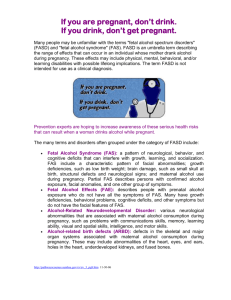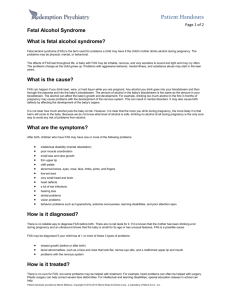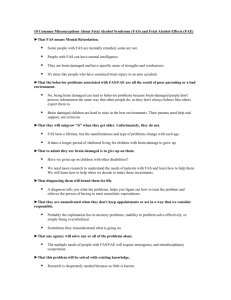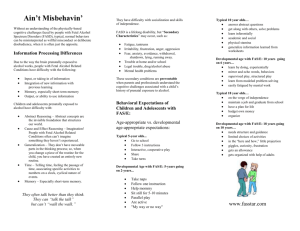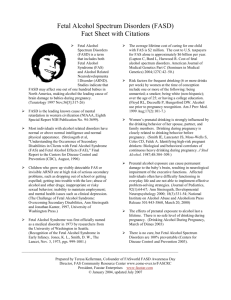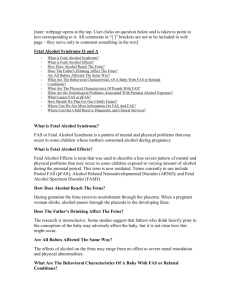OCR Document - Suffolk County Community College
advertisement
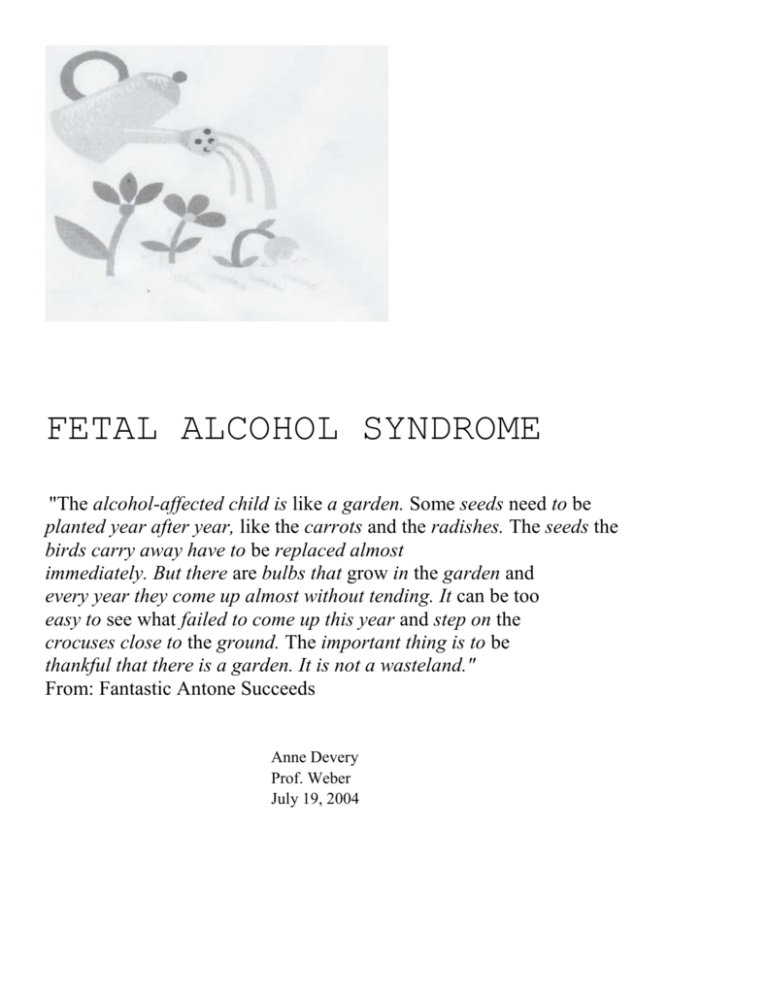
FETAL ALCOHOL SYNDROME "The alcohol-affected child is like a garden. Some seeds need to be planted year after year, like the carrots and the radishes. The seeds the birds carry away have to be replaced almost immediately. But there are bulbs that grow in the garden and every year they come up almost without tending. It can be too easy to see what failed to come up this year and step on the crocuses close to the ground. The important thing is to be thankful that there is a garden. It is not a wasteland." From: Fantastic Antone Succeeds Anne Devery Prof. Weber July 19, 2004 My topic for this research paper is Fetal Alcohol Syndrome (FAS). I decided to do research on this topic because I know a family that was affected by this syndrome. This family had two daughters. One of the daughters had very severe physical signs of FAS. She was blind; her cognitive development was delayed, as well as her motor skills. When she finally learned to walk, she would walk backwards. The other daughter had no physical signs of this syndrome. She seemed to develop at an appropriate rate. The mother was told during both pregnancies to stop drinking. She did not stop before, during, and after her two pregnancies. Also, the father was an alcoholic. Unfortunately it has been several years since I have seen them, but I have always been curious about this syndrome. I am curious as to why one daughter was so strongly affected by FAS and the other daughter was not. I would like to know what FAS affects. I am interested in how many children are affected by FAS. Are there different levels of FAS? If the father is an alcoholic will it affect the development of the child? When I started this assignment, I went to the Middle Country Public Library. I was surprised that most of the books were outdated. I was looking for books published in the last five years. I found only one book that was current on FAS. The book is Our FAScinating Journey, by Jodee Kulp. I decided to try the internet. I wasn't able to access the ERIC database. I tried at the library and at home and both times I was unsuccessful. Finally, I found information from using google.com. I came across many different websites containing important facts about FAS. I also contacted the March of Dimes because their mission is to improve the health of babies. They also have completed much research on pregnancy. One website that I found important is The National Organization on Fetal Alcohol Syndrome. This website contained facts about FAS. This is effective because it defined FAS. The article that I was most fascinated by was "Strategy and Structure Essential for Children with FAS Disorders." The article had mentioned that there is an 18-hour window which would determine if the child will have facial features of FAS. The National Organization on Fetal Alcohol Syndrome states that "FAS is a lifelong yet completely preventable set of physical, mental, and neurobehavioral birth defects associated with alcohol consumption during pregnancy." There are lesser degrees of Fetal Alcohol Syndrome. They are Fetal Alcohol Effects (FAE), Fetal Alcohol Spectrum Disorder (FASD), Alcohol-Related Birth Defects (ARBD), and Alcohol-Related Neurodevelopmental Disorder (ARND). Children with FAE or FASD can have some mental or physical characteristics of FAS. (March of Dimes Birth Defects Foundation p. 2) ARDB can affect the heart, bones, kidneys, hearing, or vision systems. ARND could affect, the babies head size at birth, impaired fine motor skills or cause brain abnormalities. (Warren & Foudin p.154) Alcohol produces more abnormalities in a developing fetus than cocaine, marijuana, or heroin. When a mother drinks, she is risking mental and physical deficiencies to her unborn baby. It wasn't until 1973 that alcohol was considered a teratogen. A teratogen is a substance that can cause damage to the fetus. (Rutherford p.1) According to Teresa Kellerman, one out of every 750 infants is born with full FAS. There are between 35,000 and 50,000 babies born with other alcohol related disorders each year. She states that women at the highest risk of drinking during pregnancy include women who are single, women in households with incomes over $50,000, women who are in college, or have a degree, and women who also smoke. More than 50% of women in their childbearing years drink alcohol, but only 39% of them know about FAS. (Kellerman p.1) There are many different effects of FAS. Children have characteristics of low birth weight, small head circumference, facial abnormalities, Epilepsy, learning difficulties, difficulties with fine motor skills, organ dysfunctions, and delays in development. The facial abnormalities include flatten cheekbones, underdeveloped groove between the nose and the upper lip, and smaller eye openings. (Rutherford p.1) Between eight months and eight years of age, facial signs of FAS are most noticeable. (Koren, Nulma, Chudley, & Loocke p. 2) Some children have behavior problems including trouble concentrating, ADHD, social withdrawal, anxiety, and can be impulsive. (Rutherford p.1) Researchers have looked into the timing of drinking and fetus development. According to Warren and Foudin not all women that drink will give birth to a child with FAS. It is believed that it is not the total amount of alcohol that is consumed but the high number of drinks consumed at one occasion. This will produce a high blood alcohol concentration that can affect the fetus. (Warren & Foudin pgs. 155 & 156) "There is a small 18- hour window in the ninth week (of pregnancy) where you can actually get the facial features that will give the diagnosis of FAS. If mom, no matter who this mom is, didn't drink for those 18-hours, the child has no facial features of the syndrome and does not get the syndrome diagnosis. But he has all the disabilities, all the learning problems, all the behavioral issues," said Gelasco. (Dansereau '& Sweetgrass p. 1) At different stages of development, the fetus is vulnerable to brain damage when alcohol is encounfered. (Dansereau & Sweetgrass p 1) During the first trimester of pregnancy, the baby's internal organs and the brain are affected by alcohol. In the second trimester, the size and the intelligence of the baby are affected. The baby's intelligence is more at risk during the third trimester. (Black p. 56) Some newborns with FAS have withdrawal symptoms. They have prolonged twitching, hyperactivity, sweating, and jitteriness. If an infant is overstimulated or anxious, they may thrash about. (Black p. 56) It is important for women who are breastfeeding not to drink alcohol. It is believed that small amounts of alcohol can get into the breast milk. This milk can affect the motor skills of the baby. (March of Dimes p 2) Not only does the mother's drinking affect the baby, but the father's drinking also affects the baby. It is believed that alcohol damages DNA and can cause deformities in newborns. An infant who is born to a father who drinks regularly weighs less that those whose fathers are occasional drinkers. (Black p. 56) Since the public needs to be aware of the affects of FAS, the Institute of Medicine (IOM) has proposed three levels of prevention. They are universal prevention, selective prevention, and indicated prevention. "Universal prevention targets an entire population group and can include such components as health advisories, public service announcements, and health articles and brochures distributed through a variety of outlets. Selective prevention targets specific groups whose risks are higher than the population in general. For example these people may reside in a community with heavy per capita alcohol use. Indicated prevention targets individuals, rather than groups, known to be at high risk because of specific risk factors; for example, a person with a known drinking problem or who has previously given birth to a child with FAS. " (Warren & Foudin p. 156) I would like to know why mothers continue to drink alcohol while being pregnant. I would also like to know why babies are allowed to leave the hospital with their mothers that drank during pregnancy. Is there a program that a baby can go into foster care, while their mother stays sober? A mother who drinks can't take care of a newborn's everyday needs. To try to find out these answers, I will contact the March of Dimes and The National Organization on Fetal Alcohol Syndrome for more information. I would share this information with expecting mothers and fathers and pass this on to prevention groups. This assignment answered my questions about FAS. I found it very interesting and informative. I think more should be done to warn parents about the effects of FAS. Is drinking worth risking a child’s life? Works Citied Black, Susan. "When Parents Drink During Pregnancy." The Executive Educator 15 (June 1993) 55-57. Dansereau, Inna and Alberta Sweetgrass. "Strategy and Structure Essential For Children With FAS Disorders." MasterFile Premier Nov 2001: EBSCO Host. Middle Country Public Library. 7 July 2004. http://web8.epnet.com/citation.asp?tb=1&_ug=sid+A27DB14A%2D5318%2D5318%2D46AA%2D A... Drinking Alcohol During Pregnancy. March of Dimes. 7 July 2004. http://www.marchofdimes.com/professionals/681 1170.asp FAS/FASD/ARND/ARBD. The National Organization on Fetal Alcohol Syndrome. 7 July 2004. http://www.nofas.org/main/FAS-FASD-ARND-ARBD.htm Kellerman, Teresa. "FAS Facts." 7 July 2004 http://www.fasstar.com Koren, Gideon, Irena Nulman, Albert E. Chudley, Christine Loocke. "Fetal Alcohol Spectrum Disorder" Canadian Medical Association Journal 25 Nov. 2003: EBSCO Host. Middle Country Public Library. 7 July 2004. http://web8.epnet.com/citation.asp?tb=1&_ug=sid+A27DB14A%2D5318%2D5318%2D46AA%2D A... Rutherford, Kim. Fetal Alcohol Syndrome. Kids Health. 13 July 2004. http://kidshealth.org. Warren, Kenneth R. PH.D. and Laurie L. Foudin PH.D. "Alcohol-Related Birth Defects- The Past, Present, and Future." Alcohol Research & Health 25.3 (2001): 153-158.



